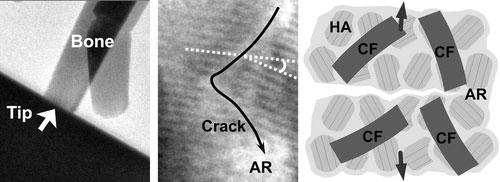| Oct 10, 2013 |
Nanoscopic observations of the performance of healthy and osteoporotic bones
|
|
(Nanowerk News) Bone is a complex, hierarchical tissue and comprises different levels of structures, from the macroscale cortical and trabecular bones to the nanoscale bundles of mineralized collagen fibers. At the nanoscale, bone consists of calcium salts (mostly hydroxyapatites in the form of nanocrystalline flakes) grown from an organic matrix (mainly collagen fibers and few protein-based ground substance).
|
|
Researchers in Taiwan and Singapore have addressed the nanoscale deformation and fracture of sham and OVX mouse bones as well as the correlation between the changes in bone structures and the consequent decline in mechanical properties upon osteoporosis at the nano and atomic scales via in situ TEM observations of cortical bone nanopillars undergoing compression.
|
|
Reporting their findings in Nano Letters ("Nanomechanics Insights into the Performance of Healthy and Osteoporotic Bones"), they showed that the osteoporotic change in bone nanostructure obtained from micro-CT analyses and bone mineral densities was more significant for cancellous bone than that for loadbearing cortical bone.
|
 |
| The structural–mechanical property relationship at the atomic scale suggests that cortical bone performance is correlated to the feature, arrangement, movement, distortion, and fracture of hydroxyapatite nanocrystals. Healthy bone comprising tightly bound mineral nanocrystals shows high structural stability with nanoscopic lattice distortions and dislocation activities. On the other hand, osteoporotic bone exhibits brittleness owing to the movements of dispersed minerals in and intergranular fracture along a weak organic matrix. (© ACS)
|
|
The structural integrity and mechanical performance of cortical bone can be obtained from understanding of the feature, arrangement, movement, distortion, and fracture of inorganic hydroxyapatite nanocrystals located within an organic matrix.
|
|
Thus, understanding bone mechanics at the nanoscale can give important insights into how the mechanical response of osteoporotic cortical bones can differ from that of healthy bones.
|

